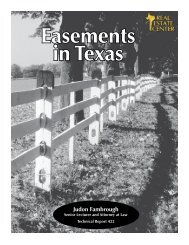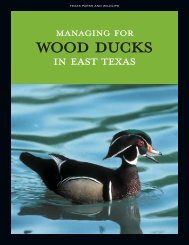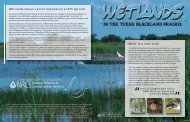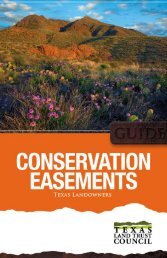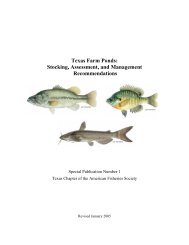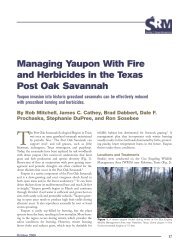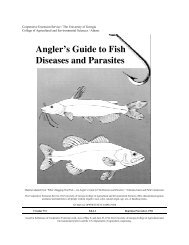Benefits of Wetlands - Trinity Waters
Benefits of Wetlands - Trinity Waters
Benefits of Wetlands - Trinity Waters
- No tags were found...
You also want an ePaper? Increase the reach of your titles
YUMPU automatically turns print PDFs into web optimized ePapers that Google loves.
County Spotlight –Pima County, ArizonaPima County is a growing county and is currently thesecond largest <strong>of</strong> the four original Arizona counties. Accountingfor 9,187 square miles <strong>of</strong> southern Arizona, thecounty includes the city <strong>of</strong> Tucson and is a large urbancounty with a population in 2000 <strong>of</strong> over 840,000 people.Pima County is protecting endangered species andhabitats through the Sonoran Desert Conservation Plan.The Sonoran Desert is rich in biodiversity and one <strong>of</strong> thetop eco-regions in the world. Pima County is committedto the long-term survival <strong>of</strong> native plants and animals andthe conservation <strong>of</strong> its cultural resources, and now has asingle plan comprised <strong>of</strong> natural resource protection andland use planning activities. The county’s conservationplan places priority on preserving and protecting thesenatural resources while also being mindful <strong>of</strong> growth inthe area.Pima County recognizes that 60 to 75% <strong>of</strong> all speciesin the state <strong>of</strong> Arizona depend on a riverine area orwetland at some point in their life cycle. So the county’splan includes guidelines on the conservation <strong>of</strong> 95% <strong>of</strong>the wetland areas that will be affected by developmentthrough conservation easements, restoration projects,zoning revisions, and partnerships with public and privateentities. To learn more about Pima County’s role in the SonoranDesert Conservation plan visit: www.co.pima.az.us/cmo/sdcp/index.html.Wetland and <strong>Waters</strong>hed-Related Resourcesfor Local Governments● National Association <strong>of</strong> Counties (NACo) – providescounty <strong>of</strong>ficials with wetlands and watershed technicaland legislative assistance as well as funding through theFive Star Restoration Challenge Grant Program. NACo is apartner in this EPA funded program that supports community-basedwetlands restoration projects. www.naco.org/techassistance under Water Quality or contact Erik Johnstonat (202) 942-4246 or ejohnston@naco.org.● U.S. Environmental Protection Agency (EPA), <strong>Wetlands</strong>Division – provides comprehensive informationon laws and regulations, benefits <strong>of</strong> preserving wetlands,financial assistance and regional resources. www.epa.gov/owow/wetlands– For a wide range <strong>of</strong> wetlands fact sheets go towww.epa.gov/owow/wetlands/facts/contents.html.– View the wetlands publications list at www.epa.gov/owow/wetlands/wetpubs.html.– The EPA <strong>Wetlands</strong> Information Hotline 1-800-832-7828 isavailable Monday through Friday 8:30 am to 5:30pm ESTto provide specific information on wetlands regulation,legislation and policy, or to order resources.● Association <strong>of</strong> State Floodplain Managers – Thegoal <strong>of</strong> this association is to mitigate the losses, costs andhuman suffering caused by flooding and to promote wiseuse <strong>of</strong> the natural and beneficial functions <strong>of</strong> floodplainsthrough policy and practice changes. www.floods.org/home/default.asp● Association <strong>of</strong> State Wetland Managers – Providespamphlets, books, brochures, white papers and summaries<strong>of</strong> findings <strong>of</strong> symposia and workshops as well asinformation on local, state and federal wetlands programs.www.aswm.org● Center for <strong>Waters</strong>hed Protection – Provides education,outreach and training on watershed protection, planning,restoration and research as well stormwater managementand better site design. www.cwp.org● National Marine Fisheries Service RestorationCenter (National Oceanic and Atmospheric Administration)– Focuses on enhancing living marine resources tobenefit the nation’s fisheries by restoring degraded habitats,advancing the science <strong>of</strong> coastal habitat restoration, transferringrestoration technology and fostering habitat stewardshipand a conservation ethic. www.nmfs.noaa.gov/habitat/restoration/● National <strong>Wetlands</strong> Inventory Center (U.S. Fish andWildlife Service) – Provides digitized wetland maps, statusand trend reports as well as manuals, plant and hydric soilslists, field guides, posters, wall size resource maps, atlases,state reports and numerous articles published in pr<strong>of</strong>essionaljournals. www.nwi.fws.gov● National <strong>Wetlands</strong> Research Center – Is a part <strong>of</strong>the Biological Resources Division <strong>of</strong> the U.S. GeologicalSurvey and serves as a source and clearinghouse <strong>of</strong> scienceinformation about wetlands in the United States and world.www.nwrc.usgs.gov● Stormwater Manager’s Resource Center – Provideslinks to stormwater management information including:manuals, ordinances, articles, fact sheets and a library <strong>of</strong>slideshows. www.stormwatercenter.net6



